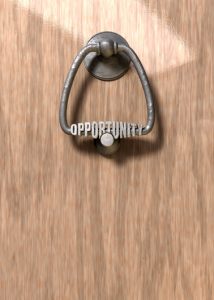
.
According to the Oxford dictionary, opportunity is “a set of circumstances that makes it possible to do something”. The opposite of opportunity is a challenge, obstacle or problem that gets in the way of seeing and acting upon new possibilities. Enter the concept of tunnel vision. In some cases, tunnel vision comes from an attitude of negativity or lack of confidence that results in acceptance of the status quo. In other cases, it’s simply a matter of people who weren’t trained to identify and capitalize on opportunities.
Successful people, in every industry and in every walk of life, have learned the skill of spotting unique opportunities. Then, they use it to their advantage. They look for opportunities every day. They analyze their challenges and come up with plans to overcome them. These are forward thinking individuals who have the capacity visualize and execute short- and long-term solutions.
Opportunity Blindness
To overcome “opportunity blindness,” sales and marketing trainer and consultant, Marty Jacknis, suggests using a methodology called MPV, which stands for minimum objectives, primary objectives and visionary objectives. In his article, “Overcome Opportunity Blindness,” published in Sales and Service Excellence Essentials in July 2014, Jacknis states that individuals can be trained to identify opportunities in each of these areas. “What sets top performers apart is their ability to seek, see seize and leverage a vast number of opportunities surrounding them at any given time,” Jacknis says.

Another approach to capitalizing on opportunities starts with a focused plan that begins with listening. Instead of talking about a challenge, obstacle or problem, ask for help. Assemble a group of bright and creative people. Ask the right questions and listen to the responses. It’s surprising how close and achievable the solution is. Second, look for ways to “tweak” a situation. Small improvements and innovation can result in new or better products and services producing more customers and a larger marketplace. Creating a competitive advantage falls in this category as does a implementing a customer-centric focus. Third, look for ways to simplify your approach. Make it easy for people to see, understand and act upon your business proposition. Show them the benefits and make sure they understand your relationship-oriented approach to business.
Opportunity Is Knocking

In the end, what separates winners and losers is the ability to create and capitalize on opportunities. While some people have a knack for spotting uncharted territory, others need to be diligent in their efforts to uncover new opportunities. Innovation can’t exist in a vacuum. So escape the trap of tunnel vision, head out into the world and practice the behaviors that will lead you to new ideas and opportunities.

